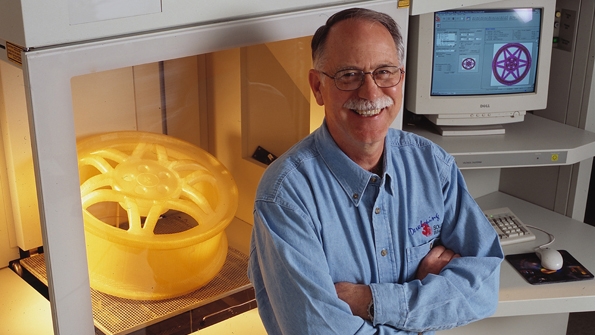With all the hubbub surrounding 3D printing as of late, it’s easy to think of it as something new. Something that, before 5 or 6 years ago, only existed in Sci-Fi novels.
Surprise! 3D printing has actually been around for decades. In fact, the first kinda-sorta functional 3D printer prototype was built way back in 1984. This year, its inventor, Chuck Hull, is being inducted into the National Inventors Hall Of Fame.
This puts him up in the ranks, in the U.S. Patent Office’s eyes, with folks like Thomas Edison, Jobs/Woz, the Wright Brothers, Einstein, and Eli Whitney.
In 1984, Hull had a realization: if you pointed a highly focused UV light at a special, goopy material (called a “photopolymer” ), the material would instantly turn solid wherever the light would touch. If you did this repeatedly, layer by layer, you could “print” an object into existence. He dubbed it “stereolithography“, and bam! 3D printing was born.
3D printing has come a long way since 1984, of course. Materials — and the objects being printed with them — have gotten much, much stronger. We’ve developed new techniques, like laser sintering (which companies like Tesla use to print their prototypes in metal) and FDM extrusion (think Makerbot, which uses quick-solidifying melted plastic to print its layers). Most importantly, the software has gotten easier to use and the hardware has gotten cheaper — and it’s only going to get better.
But it all started in ’84 — and for that, Hull is finding his place in the National Inventors Hall Of Fame.
(To connect some dots here: when you hear people talking about those “important 3D printing patents” expiring that’ll open the floodgates for affordable 3D printers in the home, they’re often talking about Hull’s patents and those owned by his company, 3D Systems.)
Another name you might recognize, inducted this year: Actress Hedy Lamarr, who, along with composer George Antheil (also being inducted), invented one of the earliest forms of frequency hopping — a technology that, while initially created to help keep the Navy’s torpedoes from getting jammed, can now be found in everything from WiFi routers to Bluetooth headsets.
